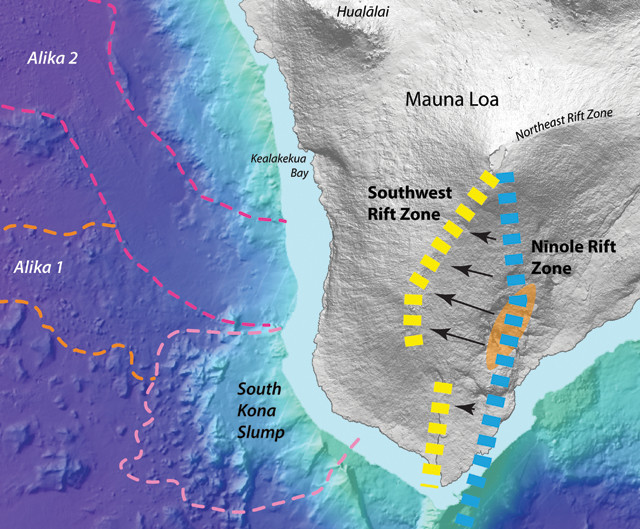
by Mary Caperton Morton Tuesday, July 26, 2016

The Nīnole Hills (orange area) on the southeast flank of Mauna Loa are suggested to be a failed rift (blue dashed line) that migrated toward the current Southwest Rift Zone (yellow dashed line). Credit: U.S. Geological Survey.
Hawaii’s Nīnole Hills, jutting out from Mauna Loa’s southeast flank, are one of the most striking features on the Big Island, though their geologic origins have long been a mystery. A new study looking at gravity anomalies under the hills is revealing that the hills are part of an older rift system that predates the currently active Southwest Rift Zone. The seemingly sudden switch from one rift system to another may provide some clues as to how Mauna Loa grew to be the largest volcano on Earth. “A lot of different ideas have been proposed to explain how the Nīnole Hills were created,” says Jeff Zurek, a geophysicist at Simon Fraser University in Burnaby, British Columbia, and lead author of the new study published in Geophysical Research Letters. It’s been suggested that the hills could be the remnants of an older summit of Mauna Loa, or its predecessor, Mohokea, or that faulting and landslides could have created the unusual topography of the hills, or that they could be from an older, inactive rift system.
One of the most intriguing clues is their age: The lava flows that make up the Nīnole Hills are about 125,000 years old, vastly older than the rest of Mauna Loa’s surface lava flows, 90 percent of which date to less than 7,000 years old. “The age of the hills hints at something exotic,” says Julia Morgan, a geologist at Rice University in Houston, who was not involved in the new study. Previous seismic studies conducted by Morgan and colleagues found evidence that the hills were once part of a rift that ran from the summit of Mauna Loa through the hills and out to sea.
Using a different geophysical approach, Zurek and colleagues used a portable gravity meter to map the interior of the hills in fine detail. The gravity surveys identified areas of high- and low-density rocks. Rift zones, where repeated magma intrusions cooled underground, contain denser rocks, whereas lavas that erupted at the surface are lower density. The team found a high-density gravity anomaly about 5 kilometers long, elongated in a northeasterly to southwesterly direction, consistent with the shape and dimensions of an old rift zone. But even though both studies found evidence that the Nīnole Hills represent an old rift zone, their interpretations of how the rift was abandoned differ.
Morgan and colleagues propose that the offshore rift zone became inactive when volcanic activity migrated upslope, toward the summit of Mauna Loa, whereas Zurek and colleagues think the rift zone activity shifted westward, somewhat abruptly, toward its present location. Further clues are found on the western flank of Mauna Loa, which has undergone at least three mass wasting events, the last dating to about 127,000 years ago, around the time that the rift underlying the Nīnole Hills was migrating and/or becoming inactive.
“The mass wasting on Mauna Loa’s western flank likely caused a reorganization of the structure of Mauna Loa and opened up new pathways for magma to rise to the surface,” Zurek says. The unloading of the crust presented easier pathways for magma to rise and erupt; thus, the old rift that underlies the hills, where magma had to push its way to the surface, was abandoned in less than a few thousand years.
Large-scale rift reorganization might be more common in volcanic systems than is currently recognized, Morgan says. “We think this kind of reorganization might be part of what makes Mauna Loa such a large volcano. The fact that it has undergone such large-scale reorganizations might be the reason it’s been able to keep producing such large eruptions.”
© 2008-2021. All rights reserved. Any copying, redistribution or retransmission of any of the contents of this service without the expressed written permission of the American Geosciences Institute is expressly prohibited. Click here for all copyright requests.